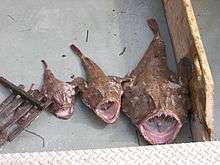Lophius americanus
| Lophius americanus Temporal range: Pliocene-Recent, 5.3–0 Ma | |
|---|---|
 | |
 | |
| American angler | |
| Scientific classification | |
| Kingdom: | Animalia |
| Phylum: | Chordata |
| Class: | Actinopterygii |
| Order: | Lophiiformes |
| Family: | Lophiidae |
| Genus: | Lophius |
| Species: | L. americanus |
| Binomial name | |
| Lophius americanus Valenciennes, 1837 [1] | |
Lophius americanus is a goosefish in the family Lophiidae, also called all-mouth, American anglerfish, bellows-fish, devil-fish, headfish, molligut, satchel-mouth, or wide-gape. It is native to the eastern coast of North America.
Description
The American anglerfish is unique in its appearance and has no relatives with which it can be confused in the areas where it is caught. A fish of lesser importance than other food fish in the region, such as cod, its various names suggest its unusual appearance - a very large mouth, more than twice the width of the tail, with several spines and strong teeth, enabling it to snare prey larger than itself. The body is flattened dorsoventrally to allow it to hide on the sea floor. The front of the head carries erectile spines, the primary of which has a flattened end to resemble a small organism or piece of algae. The pectoral fins are like wide fans behind the head, and the pelvic fins are like small hands below the head.
The American anglerfish can grow to a length of 140 cm (55 in), but 100 cm (39 in) is a more usual size. The greatest recorded weight is 22.6 kg (50 lb) and the greatest recorded age is 30 years.[2]
Distribution and habitat
The American anglerfish is found in the western Atlantic from Newfoundland and Quebec south to northern Florida, but is commoner in the more northerly parts of its range, north of Cape Hatteras. It is a demersal fish living close to the seabed at depths down to about 2,000 feet (610 m).[2] It is found on sand bottoms, gravel, shell fragments, mud and clay.[3]
Behaviour


Feeding
The American anglerfish is an ambush predator. It spends most of its time on the seabed partly covered in sediment waiting for suitable prey to pass. It can swim slowly or "walk" with the help of its pectoral fins. Its diet normally consists of fin and ray fish, squids, cuttlefish and occasionally carrion.[3] After storms it has been reported on the sea surface where it has been recorded as catching seabirds.[4]
Breeding and lifecycle
Spawning takes place in the summer with a peak in May and June. The eggs are large and are believed to be unique among fish in being attached to a floating mucus veil. The number of eggs in a veil can range from 1 to 3 million and the veil drifts on the surface of the sea. The eggs hatch after 6 to 100 days, depending on the sea temperature, and remain protected within the veil for a few days, absorbing nutrients from their yolk sacs. They then become pelagic and join other fish larvae in the "ichthyoplankton community". The larvae feed on zooplankton and look quite different from the adult fish, being laterally compressed and having long dorsal and pectoral fin rays. When about 7 centimetres (2.8 in) long they become juveniles, changing their appearance over a period of several weeks into the adult shape and starting to live on the seabed. They grow fast in their first year and more slowly thereafter.[3]
Food use
The flesh of the anglerfish is located primarily in the body, less so in the "shoulders" and cheeks. The flesh is very white and moist, becoming quite firm when cooked. It is served both in soups and grilled, and is similar in texture to the flesh of crustaceans. Fillets are thick and boneless resembling crab or lobster tail. Connoisseurs believe the liver is also excellent. The fish is covered with a soft, scaleless, elastic skin, under which another thin edible membrane covers the flesh. Though much less so than in cod, one can sometimes find parasitic worms in the flesh of anglerfish, whose opacity can make them easier to find. Worms are usually found between the skin and outer portion of the flesh ranging in size from a few millimeters to over one inch.
Sustainable consumption
In 2010, Greenpeace International added Lophius americanus or the American anglerfish to its seafood red list. "The Greenpeace International seafood red list is a list of fish that are commonly sold in supermarkets around the world, and which have a very high risk of being sourced from unsustainable fisheries."[5]
Notes
- ↑ Bailly, Nicolas (2010). "Lophius americanus Valenciennes, 1837". World Register of Marine Species. Retrieved 2012-01-06.
- 1 2 Lophius americanus Valenciennes, 1837 FishBase. Retrieved 2012-01-06.
- 1 2 3 "Goosefish, Lophius americanus, Life History and Habitat Characteristics" (PDF). US Department of Commerce: National Marine Fisheries Service. 1999.
- ↑ Bigelow, H.B. and W.C. Schroeder (1953). "Fishes of the Gulf of Maine". Fishery Bulletin. U.S. Fish & Wildlife Service. 53: 1–577.
- ↑ Greenpeace International Seafood Red list
References
- Monkfish NOAA FishWatch. Retrieved 11 November 2012.
- Dictionary of American Regional English